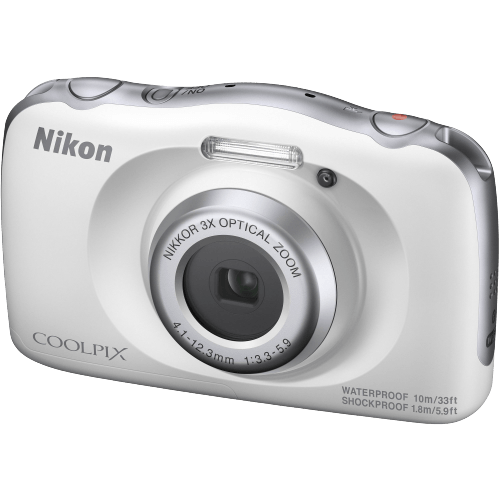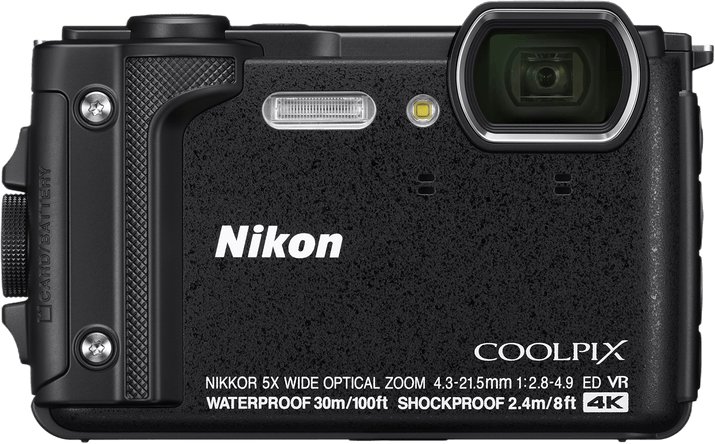Nikon CoolPix W150 vs W300 Comparison
Nikon CoolPix W150

Nikon W300

The Nikon W300 comes out on top with a score of 54/100, a mere 3-point lead over the Nikon CoolPix W150, which scores 51/100. Both cameras share compact design and similar dimensions, with the W150 measuring 110 x 67 x 38mm and the W300 at 112 x 66 x 29mm. However, the W300 is slightly heavier at 231g compared to the W150’s 177g.
The winning W300 offers advantages despite its higher launch price of $389, compared to the W150’s $150. Its superior score is well-deserved due to its enhanced features and performance. On the other hand, the W150 is a more budget-friendly option, making it a great choice for casual photographers who want a compact and lightweight camera.
Taking these factors into account, the Nikon W300 is the better camera for those willing to invest in higher quality and performance, while the Nikon CoolPix W150 is perfect for those seeking a more affordable yet still capable camera.
Nikon CoolPix W150 vs W300 Overview and Optics
The Nikon W300 wins the optics comparison with a score of 52/100, while the Nikon CoolPix W150 scores 50/100. Both cameras have similar specifications, including a CMOS sensor, unspecified processor, fixed lens mount, and image stabilization. They also share the same DXOMARK score for the sensor, which is 72.
The Nikon W300 has a higher megapixel count of 16, compared to the W150’s 13 megapixels. This difference allows the W300 to capture more detail in images, resulting in better overall image quality. Additionally, the W300 has a larger sensor size of 1/2.3″ compared to the W150’s 1/3.1″ sensor. A larger sensor size contributes to improved low-light performance and dynamic range, giving the W300 an advantage in various shooting conditions.
On the other hand, the Nikon CoolPix W150 has a faster shooting speed of 11 compared to the W300’s 7. This means that the W150 is capable of capturing more frames per second, which can be beneficial for action photography or capturing fast-moving subjects. However, the difference in shooting speed may not be significant enough to sway the decision for most users.
In terms of optics, the Nikon W300 comes out ahead with a higher megapixel count and larger sensor size, leading to better image quality and low-light performance. While the Nikon CoolPix W150 offers a faster shooting speed, this advantage may not be substantial enough for most users. Therefore, based on these factors, the Nikon W300 is the better choice for those prioritizing image quality and performance in various lighting conditions.
Nikon CoolPix W150 vs W300 Video Performance
The Nikon W300 triumphs over the Nikon CoolPix W150 in video capabilities, boasting a significantly higher video score of 91/100 compared to the W150’s 57/100. Both cameras share similarities in certain specs, such as having built-in time-lapse functionality, but the W300 outperforms the W150 in other areas.
The winning camera, the Nikon W300, is superior due to its impressive max video resolution of 4K and max video dimensions of 3840 x 2160. Furthermore, the W300 has a higher max video frame rate of 120fps, allowing for smoother and more detailed footage. These features make the W300 a more powerful tool for capturing high-quality videos.
On the other hand, the Nikon CoolPix W150 has a lower max video resolution at Full HD and smaller max video dimensions of 1920 x 1080. Its max video frame rate is also limited to 30fps. Although these specifications are less impressive than the W300, the W150 still offers decent video capabilities for casual users who may not require the extra resolution and frame rate provided by the W300.
Taking into account the specifications, the Nikon W300 is the superior choice for those prioritizing video quality and performance. Its 4K resolution, larger video dimensions, and higher frame rate undoubtedly make it a better camera for capturing videos. Meanwhile, the Nikon CoolPix W150 still offers satisfactory video capabilities for casual users, but its limitations make it a less suitable option for those looking for higher video performance.
Nikon CoolPix W150 vs W300 Features and Benefits
The Nikon W300 emerges as the winner in the comparison of features, scoring 68 out of 100 points, while the Nikon CoolPix W150 scores 60 points. Both cameras share several specifications, such as the absence of a touchscreen and flip screen, as well as the presence of WIFI and Bluetooth connectivity.
The W300 outperforms the W150 in some key aspects. It has a larger screen size of 3 inches compared to the W150’s 2.7 inches, providing a better viewing experience. The W300 also boasts a significantly higher screen resolution of 921,000 dots, compared to the W150’s 230,000 dots, resulting in a much sharper display. Additionally, the W300 features GPS functionality, which the W150 lacks, allowing users to geotag their photos and track their adventures with ease.
However, the W150 excels in certain areas. Its smaller screen size and lower resolution may contribute to a longer battery life, as less power is required to operate the display. This could be advantageous for users who prioritize battery life over screen size and resolution.
To conclude, the Nikon W300’s higher feature score is a result of its larger screen size, higher screen resolution, and GPS functionality. These features make it a more versatile camera, suitable for users who prioritize a better viewing experience and advanced tracking capabilities. On the other hand, the Nikon CoolPix W150 may be more appealing to users who value battery life and do not require GPS functionality.
Nikon CoolPix W150 vs W300 Storage and Battery
The Nikon CoolPix W150 triumphs over the Nikon W300 in storage and battery with a score of 27/100 compared to the W300’s 16/100. Both cameras share similarities, including one memory card slot and compatibility with SD, SDHC, and SDXC (UHS-I compatible) memory cards, as well as internal storage.
The W150 boasts a superior feature with its USB charging capability, which the W300 lacks. This allows for convenient charging on-the-go without needing a separate battery charger. However, the W300 outperforms the W150 in battery life, offering 280 shots per charge compared to the W150’s 220 shots. This is due to the W300’s use of the EN-EL12 battery type, while the W150 uses the EN-EL19 battery type.
Despite the W300’s longer battery life, the CoolPix W150’s overall storage and battery score is higher, primarily because of its USB charging advantage. The W300’s extended battery life cannot compensate for the convenience of USB charging, making the W150 the preferred choice in this category.
Nikon CoolPix W150 vs W300 – Our Verdict
Are you still undecided about which camera is right for you? Have a look at these popular comparisons that feature the Nikon CoolPix W150 or the Nikon W300:
